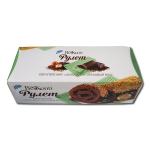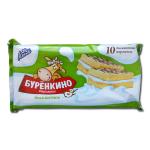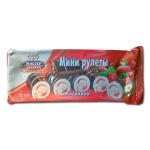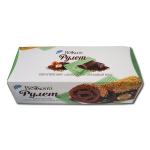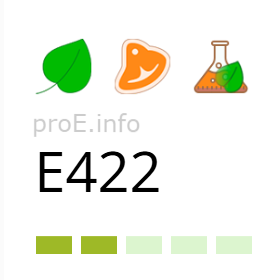
Other names for the additive (synonyms)
General Information
Glycerol is a food additive labeled as E422, and it is the simplest representative of trihydric alcohols. It is a viscous, colorless, sweet-tasting liquid that is infinitely soluble in water. The name of the substance comes from the Greek word glycos, meaning “sweet.” The chemical formula of glycerol is C3H5(OH)3.
The substance was first obtained by Swedish chemist Carl Scheele in 1779 during the saponification of fats. In industry, glycerol is produced by the hydrolysis of natural fats and oils — of both animal and plant origin. Glycerol is often a byproduct of soap or biodiesel production.
Industrial production of glycerol (additive E422) is mainly carried out through the hydrolysis of natural fats and oils — of both plant and animal origin. This process is based on the decomposition of triglycerides (the main components of fats and oils), which contain fatty acid residues and a glycerol molecule.
Hydrolysis can occur under different conditions:
- Alkaline hydrolysis (saponification): fats are treated with an aqueous solution of alkali (usually sodium or potassium hydroxide) under heat. As a result, soaps (fatty acid salts) and glycerol are formed. This method is widely used in the soap industry.
- Acid hydrolysis: concentrated sulfuric or hydrochloric acid is used to break the ester bonds of triglycerides, releasing glycerol and free fatty acids.
- Hydrolysis with superheated steam: raw materials (fats and oils) are treated with steam under high pressure (usually 200–250 °C and 20–30 atmospheres). Triglycerides are broken down into glycerol and fatty acids without the addition of reagents.
In addition, glycerol can be obtained as a byproduct during the production of biodiesel. During transesterification of vegetable oils with methanol in the presence of a catalyst (e.g., sodium hydroxide), methyl esters of fatty acids (biodiesel) and glycerol are formed.
The obtained glycerol is then purified from impurities: water, salts, methanol, fatty acids, and other components. This is achieved through filtration, neutralization, distillation, and bleaching.
In the food industry, only highly purified food-grade glycerol can be used as additive E422.
In recent years, the proportion of raw materials derived from genetically modified plants (such as soy or corn) in the production of additive E422 has increased, which raises discussions about the safety and ethics of such sources.
Glycerol has good hygroscopic properties — the ability to attract and retain moisture. Because of this, it is used in food products as additive E422 as a humectant, improving texture and extending shelf life. Additionally, it enhances the solubility of other substances.
Effects on the Body
Benefits of additive E422
Currently, there is no scientific evidence of clear health benefits from glycerol consumption. Additive E422 is not a substance naturally occurring in the human body.
In pharmacology, glycerol is used as a laxative and as a base for certain solutions and syrups.
Risks of additive E422
In moderate amounts, the additive is considered safe and well-tolerated. However, excessive consumption may cause side effects such as flatulence, diarrhea, or dehydration.
Long-term consumption of products with high glycerol content may irritate the stomach lining. There are also reports of possible allergic reactions in sensitive individuals.
In 2017, the EFSA Panel on Food Additives and Nutrient Sources Added to Food (ANS) conducted a re-evaluation of food additive E422 and concluded that it is completely safe for use in food products.
Uses
Additive E422 is widely used in the food industry as a humectant, solvent, stabilizer, and sweetener. It is commonly found in:
- chocolate products, cakes, and pastries;
- chewing gum;
- some alcoholic beverages (e.g., liqueurs);
- diet foods and sugar substitutes.
Due to its moisture-retaining ability, glycerol helps maintain the softness and freshness of confectionery. It also improves the consistency and solubility of other ingredients.
Other areas of application include:
- production of cosmetics and soap;
- paper manufacturing;
- leather processing;
- production of adhesives, antifreeze, or similar substances;
- explosives manufacturing (in the form of nitroglycerin);
- use as biofuel;
- application in pharmaceutical products (mainly as a laxative).
Legal Status
Additive E422 is officially approved for use in the food industry in most countries, including Ukraine, the European Union, and the United States.
